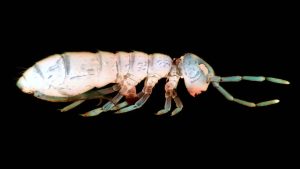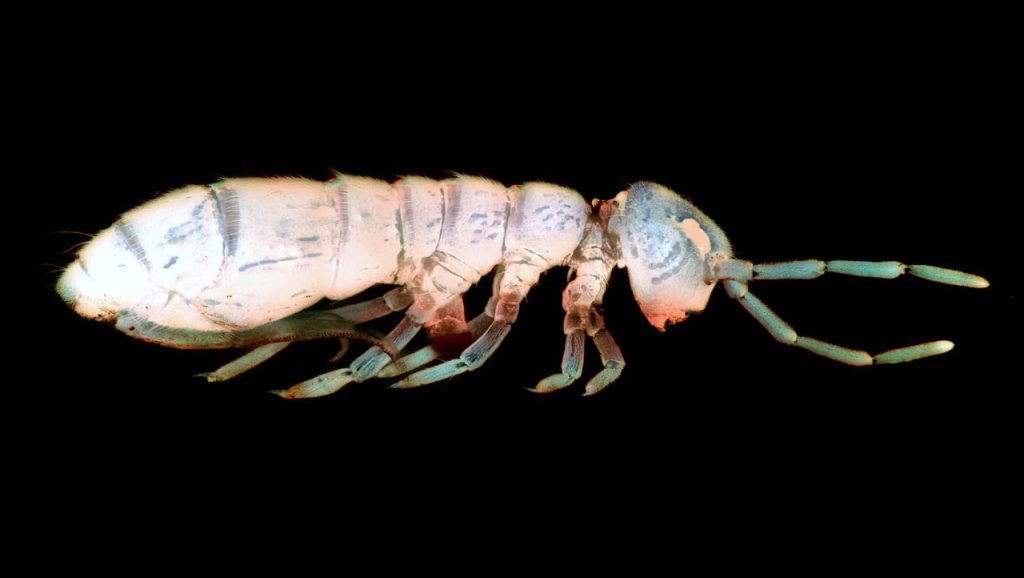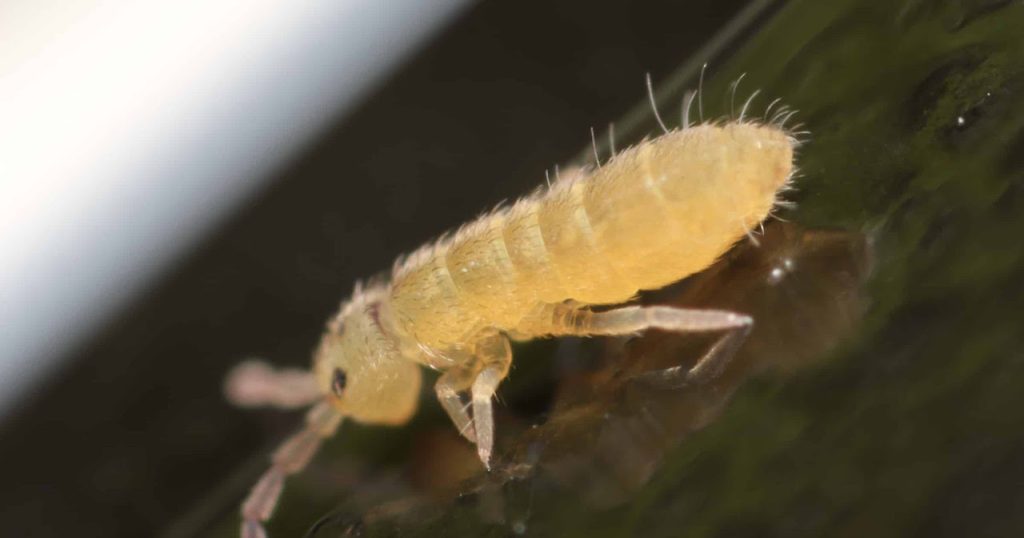
Everything You Wanted to Know About Collembola & Were Afraid to Ask
Everything You Wanted to Know About Collembola & Were Afraid to Ask
Over the years I have written several blog posts about Collembola. In this one, I put them all together which is probably the most informative collection of information you will ever find about these amazing organisms.
What are Collembola?
Collembola is a 6 legged creature about 250 microns (size of a dust particle) in length and is rod shaped with a hinge like springing apparatus in the middle – see images below. For years it was classified as an insect, but more recently it has it’s own classification, Collembola. There are over 6,000 species world wide and thy have been on this earth for millions and millions of years. They are the planet’s garbage disposal system by consuming fungi, organic matter like dead leaves to keep our planet clean. In my book is a reference that finds about 19 of the 6,000 species have an affinity for flesh (our flesh).
Without a microscope, they are basically invisible to the human eye. When they are on the skin, they blend right in and are invisible. In fact they are often called the Invisible Bug Biting Syndrome, (IBBS).
What the experts, parasitologists, etymologists and doctors say about Collembola
Unfortunately, as much as they know about Collembola, there’s so much that they don’t know. The article states, “Classified in phylum Arthropoda, class Entognatha, subclass Collembola, springtails are not harmful to humans unless they pop into your house by the hundreds for a visit and become a nuisance. They live on algae, fungi, and detritus, and rarely harm plants”
We only wish that statement were true – that they are just nuisance. And of course, these same experts claim Morgellons is not a real disease.. It’s absolutely weird that from my estimation there are tens of thousands of us who live the nightmare of being impacted by spring tails. Aside from the research study referenced in my book done by the Pediculosis Society in 2002 and a Swedish study done in 1955, no one is studying these organisms. Click here for the study done in Sweden.
“A study conducted under the auspices of the National Pediculosis Association (NPA) in Needham, Mass. and the Oklahoma State Department of Health found over 90% of those in the study diagnosed with delusions of parasitosis were infested with Collembola. COLLEMBOLA (SPRINGTAILS) (ARTHROPODA: HEXAPODA: ENTOGNATHA) FOUND IN SCRAPINGS FROM INDIVIDUALS DIAGNOSED WITH DELUSORY PARASITOSIS in 2004 {17} Twenty people
participated in the study.”
The Various Names They Go By
Snow fleas, spring tails, and Collembola are the same thing. Are you dealing with them on or in your skin?
Why are they called snow fleas? “Often on sunny days in late winter, snow fleas work their way to the snow surface in numbers that amaze even the experienced outdoor adventurer. Why snow fleas gather on the surface of the snow is still being debated by biologists. One theory is that overcrowding and lack of food trigger them to migrate. Another theory suggests that the melting snow concentrates food at the surface.?”
How Do you Know if Collembola is Your Nemesis?
I have two questions on my questionnaire that are an indication of a Collembola infestation/infection.
p Do you ever feel like something is jumping on your ankles or legs? But it’s invisible.
p+. Do you have lots of activity around your eye lashes/eye lids – a crusty feeling?
I don’t know why they love the eye lash area, but they do. They also love the back of your head, neck and shoulder blade area and create difficult-to-heal lesions.
It took me nearly ten years to put two and two together. When I was infected in the mid 90’s my suspicions were that it was from mites. And yes, I had mites. But, I also remember waking up one morning and for some reason I glanced at my right forefinger and I noticed a tiny rod shaped thing standing on end and it looked like it was waving at me. I could not figure out how to capture it and it was lost. It certainly was not a mite.
It wasn’t until 2006, while writing my first book, “Soothing the Itch Within and the Diet to Control It,” did I hear the word Collembola from one of the people on my email list and I started putting two plus two together and realized the rod shaped thing I saw on my finger a decade ago was one Collembola organism.
Out of the millions that have been on my skin during those years, only one was visible – so you don’t see them unless they stand up and wave to you. lol
However, you can get white glue boards from www.DoYourOwnPestControl.com and set them in areas around your toilet, sink, and so on and as they jump the will be captured and you can see them against the white background.
Lately, about 95% of those who are dealing with Morgellons Disease that send in the questionnaire answer, “yes,” to tose two questions which may interest you on reading this article, “Springtails are More Noticible in Winter“. The experts have always said that spring tails can’t bite you because they do not have mouth parts. But this article claims otherwise, “Snow fleas possess very unusual mouth parts that are contained inside the head rather than protruding on the outside like other insects.”
It also notes that they can jump up to 12″ to 18″ whereas I’ve been saying 8 to 10″. But then there are 6,000 species and it’s unknown if the ones that jump 18 inches are the ones that bother us.
It’s also interesting that they can live for four years without food. And, as I’ve stated can live in a volcano as well as Antarctica.
What doesn’t make sense is that it says that the eggs are hatched in the spring and it takes about 6 months to mature. I was under the impression that they lay eggs year round and mature quickly. My experience is that they lay eggs and hatch every four days. Go figure.
The article doesn’t get into them taking up residence in moist areas of our homes or being a pest on our skin, but it’s worth a quick read.
What we know is that the King DietSM along with Nature’s Gift® products. Both diatomaceous earth or bentonite clay will shred them when they come in contact with it.
The Difference Between Collembola and Morgellons
Morgellons is characterized by the growth of filaments from our skin and lesions that are different in color than our regular hair. They can be very fine (need a 60X scope to see them) or very course. This is according to Dr. Savely’s book, Morgellons – The Legitimization of a Disease. It is my understanding that they are fluorescent under a black or ultraviolet light.
Collembola, on the other hand is not connected to these strange filaments. There is no connection between Morgellons and Collembola other than most people end up being affected by both.
But here’s the kicker: While Collembola is as predominate a problem as Morgellons, you will find many facebook groups about Morgellons but none about Collembola. And what’s more amazing, you will rarely see any reference to Collembola being mentioned on those postings.
Even Dr. Savely in her book, Morgellons – The Legitimization of a Disease claims that Collembola is not a factor as a skin parasite – more of a myth.
Why are Collembola Ignored? Collembola don’t produce weird things coming out of your skin to amaze sufferers with the camera and microscopes. Not to say Collembola won’t severely cause non healing lesions and unsightly skin, but that all seems to get blamed on Morgellons and Collembola are ignored.
Collembola Jumps are Directional – Not Indiscriminate

They have generally been described as springing non directional, like a herd of buffalo when spooked running in all directions to escape. But, more recently research indicates that most of their springing is not to escape danger but to locate a target as reported in New study shows springtails jump, dive and land with unexpected precision – The University of Maine.
This study confirms my experience of having lived with them for many years. They actually spring in a desired direction and what’s more, can adjust their flight path to reach and land on the target much like an acrobat can jump through the air performing twists and land on her feet standing up instead of falling down. Amazing!
An article, “Scientists Capture Footage Proving These Tiny Critters Are Master Acrobats,” published in Science | Animals 10/19/22 has a must see incredible video of one flying through the air to make a perfect landing.
Generally very little is published about them but it seems that 90 to 95% of those who complete my questionnaire are dealing with both Morgellons and Collembola. You find the questionnaire along with my books, diet, and many other free resources by clicking here.
One of our subscribers, Lucy found some fantastic pictures and sent this email. What is amazing is that I always assumed that mites were the carriers of Collembola, but it seems I may have had that backwards and that Collembola seem to be the carrier (vector) for mites and some nematodes to also infect our skin. Lucy writes,
“I found these fascinating photos of collembola. The explanations of the photos are also well done. What I found interesting is how mites can attach themselves to collembola as parasites and that collembola can become infected by fungus. Talk about co-infections!”
https://www.janvanduinen.nl/
Springtails: Wingless Arthropods that Can Fly is an interesting article about spring tails.

Freezing temperatures won’t destroy them but why? Why don’t these tiny organisms simply freeze to death in arctic temperatures? The answer is that these organisms developed a special anti-freeze enzyme about 400 million years ago the keeps them from freezing. “Super antifreeze in cells: The ability to survive in ice and snow developed in animals far earlier than we thought” is a very informative easy to read article published in Science Daily about Collembola. Click here to read more.
This explains how they thrive in sub freezing Artic temperatures, but how do they thrive in very hot volcanic like temperatures? Perhaps one day I’ll run across an article explaining that phenomenon as well.
Does Climate Change Affect Collembola?
“Life in the dirt is hard, and climate change isn’t helping,” is an article about how warmer climates are threatening some species of Collembola. It’s an interesting article with many colorful pictures. Apparently, the species they studied are different than the ones affecting us because even the heat of a dryer has no effect on the ones plaguing us.
|
|
Riddle: How many Collembola can Fit in Front of Your Couch?
The area in front of your couch might be a square meter. And, it’s not really a riddle. The answer is one million as noted in press release titled, Invasive species set to exploit climate change in Antarctica. I don’t know how they figured that out, but that’s a lot of organisms. Granted Antarctica has little to do with our challenge, but I thought the number of Collembola that can be in a small space phenomenal. Just one of them can be one too many and can make life miserable.
Yet, a million organisms provides you with a reference. You’re not just disinfecting to kill several organisms, but a huge number can be present. One square meter is about ten square feet–the space in front of your couch or under your table. And, they are also in every crevice. Thus, whatever you spray or fog has to reach every one of them. And remember, there are eggs there too hatching every minute which makes the job of disinfecting even more challenging. Yes, it’s overwhelming, but not impossible.
The strange thing about the article is that I didn’t see why it’s a problem or an issue for the environment if Collembola takes over Antarctica. They eat fungi and it would seem that they would not thrive unless fungi become an issue in Antarctica.
What to Do About Getting Rid of Collembola in Your Environment
As I wrote in my book, “How to Get Your Life Back from Morgellons and Other Skin Parasites,” I got infected from pulling a vine from a large pine tree in my back yard. Well, not only did I get infected, but so did the area all around that tree and any animals, such as the backyard raccoons. rabbits, ground hogs, and so on that walked through that area.
I have two options, disinfect with the Garden Safe Fungicide III or simply wear boots when I sit on the swing. For the most part I’m lazy and just wear clonker boots when I go out to the swing.
I haven’t tired either Malathion or Diazinon that are both listed in the book and have no reason to try them since the Garden Safe Fungicide III works, is easy to use, and is non toxic whereas both Malathion and Diazinon are toxic. |

